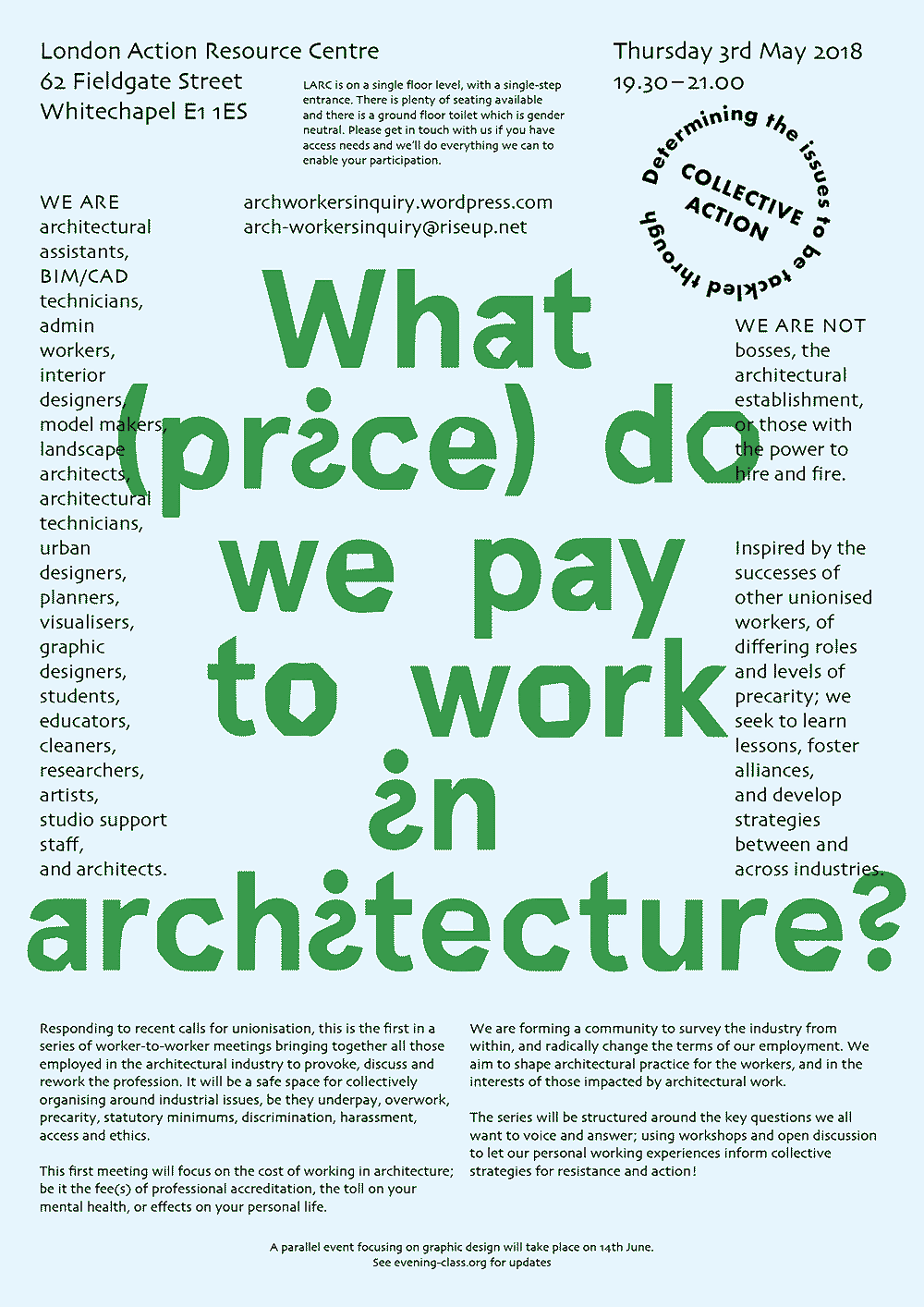The literary archetype of the hero’s quest — in which the protagonist is fated to undertake a difficult but necessary journey — primes a similar, contemporary myth: a ‘calling’. The calling is not to complete some task or travel somewhere: it is to become something. Some are ‘called’ out of a sense of martial duty to join the police or military, while others are drawn to creative fields, becoming writers, performers and visual artists. Or, architects.
The calling to be an architect, to design beautiful and meaningful places, is undeniably seductive. Ever pushed towards ‘practical’ university courses that develop skills for ‘tomorrow’s economy,’ students often feel that they must turn to finding emotional, ideological rationales for taking on the low wages, internships and debt accrued over the course of years of study that await the majority of them today. Accepting the calling can help to assuage the anxiety brought on by choosing a path rife with economic pressure. For if you’re not meant to be an architect, how else can you rationalize the experience of enduring the mental, emotional and physical stresses of years of design studios? (Many can’t, and drop out, but that’s another article.)
The axiom of ‘calling’ culturally classifies architects as artists, in a social sense, while downplaying the practical nature of designing buildings. Though architecture is a profession in the industrial sense — its practitioners must register with official bodies in order to claim the title ‘Architect’ and to sign off on building plans — the calling we investigate here suggests that architecture is also a profession in a more ideological, social or perhaps even spiritual sense; a ‘declaration of acceptance in a faith.’ Faith that, despite paying upwards of £100,000 for an architectural education in the UK and ‘probably never [making] £100,000 [a year],’ practicing as an architect will bring a degree of creative satisfaction that makes the financial compromise worthwhile. After all, it’s not work if you’re doing what you love.
This maxim, suggesting individual effort doesn’t count if it’s enjoyable, runs into trouble in the context of a business. Architecture firms are comprised of many more types of employees than architects alone. Medium-to-large sized firms employ administrative, finance, legal, public relations and business development professionals. Though critical to the business of architecture, the labor of these non-architects is generally hidden in relation to that of the architects, a phenomenon exacerbated by the cultural assumption of their calling. Just as architects are pressured to accept the myth of the calling to justify their career choice, architecture firms benefit from projecting an image of their company as a ‘studio’ or ‘collective’ comprised of people who are following their dreams. This follows from the historical model of architects’ labor within ateliers, which still exist but are far outnumbered by corporate offices. The language of joint creative labor deliberately evokes the image of the atelier. Rarely are architecture firms publicly referred to as ‘companies’ or ‘businesses,’ and rarer yet are their staff alluded to as ‘employees’ or ‘workers.’ Use of these expressions would expose the presence of non-architects who have no calling to answer and thus nothing to contribute idealistically to a culturally valuable, idyllic vision of the practice.
Just as architecture schools must inculcate the calling within the minds of their students in order for them to rationalize choosing architecture courses, architecture firms must perpetuate the calling amongst architects in order to retain them as workers, when they can’t and/or won’t raise wages or increase benefits. This constant cultural reassertion of the calling reminds architects that they like, nay, love, their work, which is crucial for maximizing their utility as workers. This process has been well documented in an investigation carried out by Duke University’s Fuqua School of Business’ and published in April 2019, titled “Understanding contemporary forms of exploitation: Attributions of passion serve to legitimize the poor treatment of workers.” The meta-study’s authors found employers “[assumed] that passionate workers would have volunteered for [demeaning tasks that are irrelevant to their job description or working extra hours without pay] if given the chance” as well as believe that “for passionate workers, work itself is its own reward.”
Passionate workers indeed volunteer for work outside their purview and work extra hours without pay. In workplaces where a minority of workers can be considered passionate, these traits can offer benefits for passionate workers’ careers insofar as they are seen as valuable and trustworthy above and beyond their less impassioned colleagues. However, in architecture firms, the myth of the calling suggests, if not assumes, that *all* architects are passionate workers, and firms in turn expect them to undertake unpaid labor. For instance, a team of architects I work with once worked six weekends in a row – eight hours both Saturday and Sunday – and received only one day of compensation afterwards. Particularly during competition periods, this type of overworking is commonplace and relied upon by firm management for the standard functioning of the company.
Since the measure of success for architecture firms is producing ‘good’ projects (read: passably ‘sustainable’, good-looking or at least not ugly or actively evil), architects can imagine that their work directly affects the firm’s future. Even junior architects with little design influence can sense value in their contribution.
Yet, if architecture firms are widely judged by their work, they escape judgement for how they treat their workers. The occasional rebuke from the profession for working conditions carries little weight when ostensibly successful firms such as Sou Fujimoto and Pritzker Prize winner Alejandro Aravena no longer employ interns. Fujimoto had previously commented that unpaid internships were a “nice opportunity” while Aravena’s firm ELEMENTAL admitted they could not afford to pay their interns. Though Pritzker leaves much to be desired as a mechanism for recognizing the field’s best (just ask Denise Scott Brown), architectural media are culpable for allowing poor business practices to go unmentioned amidst uncritical fanfare.
With that in mind, if even the most ‘successful’ firms cannot afford the labor that underpins their work, what hope is there that non-architects will be properly recognised for their efforts? Their non-billable labor is made invisible in deference to the architects’ ‘creative’ labor, which belies the unromantic reality of the profession. External communications from firms led by one or two ‘creative directors’ often also downplay the involvement of junior architects in the design process, not to mention interns. But an architecture firm’s social media, public relations, business development and ‘content creation’ staff work hard to uphold its image as a creative endeavor. These architectural ‘overhead’ workers even make *themselves* invisible when they promote individual architects as tools in their ‘employer branding’ strategies.
Firms seek to be seen as good places for architects to work. They dangle the allure of recognition for successful projects in front of these passionate workers instead of providing appropriate material compensation. Indeed, many firms do not advertise decent pay or a reasonable ‘work-life balance’ and instead extol the attractiveness of the city where the firm is located (“The city centre is on your doorstep: one of the world’s most beautiful cities”, stated a 2019 job posting from Amsterdam) and the free beer you can look forward to (“Friday afternoon drinks are waiting for you”). These employer branding strategies make use of overhead workers’ skills – writing, videography, digital dissemination – but firmly locate value in architects.
The concurrent visibility-invisibility of architects and non-architects creates a problem for both groups: it prevents coworkers from recognizing the shared barriers they face and banding together in solidarity for proper recognition of their labor.
Some architects, brainwashed by the ‘calling’, even reinforce and reproduce these barriers by belittling the work of non-architects, unable to understand what non-architects do or why they even work in an architecture firm. Overhead workers receive confused questions from architects over and over: ‘How did you get here? What did you study?’ Responding that ‘it’s a job’ almost hurts their feelings, coming dangerously close to puncturing the myth of the calling.
But the myth must be punctured! It gives cover for the hypnotic exhaustion of architectural education and the exploitation of architectural practice by supporting the idea that architects are creative geniuses the world is blessed to have; rather than, for the most part, workers carrying out mundane tasks and emotional labor. Arlie Hochschild describes emotional or affective labor as making the “effort to seem to feel (and to try to really feel) the ‘right’ feeling for the job, and to try to induce the ‘right’ feeling in certain others.” While architects are expected to perform the feeling that they are called to be architects, through such shows of dedication as overwork, their non-architect colleagues in turn must produce positive feelings about the architects. Both are responsible for expressing positive sentiment about the firm, for instance by posting favorable ‘user-generated content’ about the office environment or their current project on social media, given how much more ‘trustworthy’ it seems than the firm’s own posts.
Resetting architects’ expectations about the nature of their work, as workers, will galvanize them to claim their due rights and compensation for their labor, and end the cycle of abuses of power that justifies unpaid internships and uncompensated overtime (‘I had to do it as a young architect, so today’s young architects should too’). All architectural workers – architects and non-architects – stand to benefit as a consequence.
Towards these ends, the Architecture Lobby is exerting much-needed pressure on the American Institute of Architects and private firms in the US, creating a solidarity bloc of firms sympathetic to, believing of and willing to hire architectural workers who choose to leave firms where they’ve experienced sexual harassment.
However, the fifth point in their manifesto seeks to ‘establish a union for architects, designers, academics, and interns in architecture and design.’ Omitting non-architects ignores the not-insignificant role they play in architecture firms, and consequently, the production of the built environment. By delimiting their demands to the professionalized people of the industry, the Lobby risks creating a two-tiered system of unionized architects (and interns and academics) and non-unionized videographers, personal assistants, project controllers and marketing specialists.
In the UK, Workers’ Inquiry: Architecture likewise call for a union, though expand the workers who might comprise it, in order to include ‘admin workers’ and ‘studio support staff’, as well as workers generally thought to be in related, but separate fields: landscape architects, planners and artists. Discarding these arbitrary silos and including non-professional workers in this vision of unionization is the most viable strategy for achieving long-lasting solidarity amongst architectural workers, and ultimately, meaningful change in the systems of power that regulate their labor and produce the built environment.
In their piece in issue 46 of Harvard Design Magazine, ‘Refusal after Refusal,’ the Adjustments Agency posed the question: “What would it mean…to stake out a position of alterity to the contemporary work ethic in order to find the room to question where we’re going, what’s driving us, and to what end?” to which I would append: what would it mean for the architectural industry to stake out a position of alterity to the myth of ‘the calling’, and name architects for what they are, workers?
Header image by Sean Kowal.


